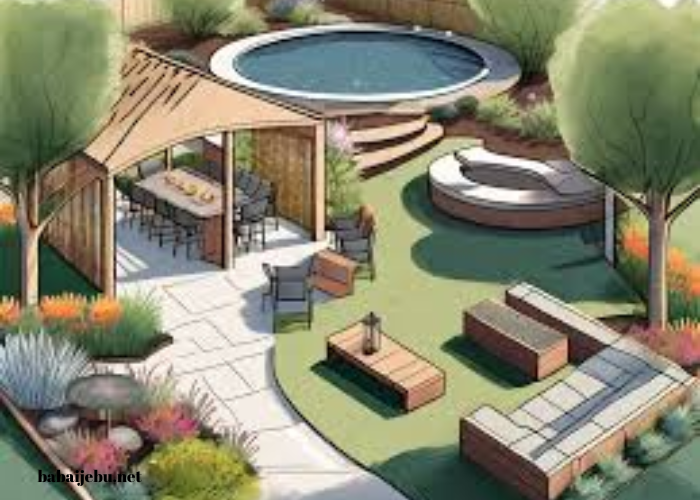Creating a picture-perfect yard requires more than just a well-maintained lawn; it demands thoughtful landscape design that balances aesthetics, functionality, and personal style. Whether you are starting from scratch or looking to enhance your existing garden, the following landscape design ideas will help you achieve a stunning outdoor space that complements your home and lifestyle.
Define Your Vision
Before diving into specific design elements, it’s crucial to define your vision. Ask yourself what you want to achieve with your yard. Are you aiming for a serene retreat, a vibrant space for entertaining, or a practical garden that supports sustainable living? Creating a mood board with images, colors, and styles you like can help clarify your vision and guide your design choices.
Start with a Plan
A well-thought-out plan is the foundation of any successful landscape design. Begin by sketching a rough layout of your yard, noting existing features like trees, pathways, and structures. Identify areas you want to enhance or change. Consider factors such as sunlight, soil type, and drainage, as these will influence plant selection and placement.
Incorporate Focal Points
Focal points draw the eye and create interest in a landscape. Incorporate features such as a beautiful water fountain, an elegant sculpture, or a striking tree to serve as the centerpiece of your yard. Focal points can be strategically placed to anchor different sections of your garden and provide a sense of balance and harmony.
Embrace Diverse Planting
A picture-perfect yard often includes a mix of plants that offer varying heights, textures, and colors. Incorporate a blend of perennials, annuals, shrubs, and trees to create visual interest throughout the year. Opt for plants that suit your climate and soil conditions, and consider their growth habits to ensure they fit well within your design.
Create Multi-Functional Spaces
Design your yard with versatile spaces that cater to different activities. For example, you might create a cozy outdoor lounge with comfortable seating, a dining area for entertaining, and a play zone for children. Use landscaping elements like hedges, pergolas, and outdoor rugs to delineate these areas and make them feel distinct yet cohesive.
Incorporate Hardscaping
Hardscaping refers to the non-plant elements of landscape design, such as patios, walkways, and retaining walls. Incorporate durable and stylish materials like natural stone, brick, or decorative concrete to add structure and function to your yard. Hardscaping can also define different zones and create visual interest by contrasting with the surrounding greenery.
Utilize Outdoor Lighting
Outdoor lighting not only extends the usability of your yard into the evening but also highlights its features. Use a combination of ambient, task, and accent lighting to create a warm and inviting atmosphere. Consider installing path lights along walkways, spotlights to showcase focal points, and string lights or lanterns for a cozy, decorative touch.
Incorporate Water Features
Water features, such as ponds, waterfalls, or fountains, can add a soothing element to your yard. They create a sense of tranquility and can attract wildlife like birds and butterflies. Ensure that your water feature is well-integrated into the landscape, and choose one that complements the overall style of your garden.
Design for Seasonal Interest
To keep your yard visually appealing throughout the year, choose plants and design elements that offer seasonal interest. Incorporate flowering plants that bloom at different times, and include deciduous trees and shrubs with colorful foliage. Consider adding evergreen plants for year-round greenery and interest.
Incorporate Sustainable Practices
Sustainable landscaping practices not only benefit the environment but also create a healthier and more resilient garden. Opt for native plants that require less water and maintenance, use organic fertilizers, and incorporate rain gardens or permeable paving to manage stormwater. These practices can help reduce your yard’s ecological footprint while enhancing its beauty.
Personalize with Unique Elements
Add personal touches to your landscape design to make it uniquely yours. This might include custom-built features like a fire pit, a vertical garden, or a custom arbor. Incorporate personal hobbies or interests, such as a vegetable garden or a collection of outdoor art. These elements will make your yard feel more like an extension of your home and lifestyle.
Consider Privacy and Screening
Privacy is an essential aspect of a picture-perfect yard. Use landscaping elements like trellises, bamboo screens, or strategically placed trees and shrubs to create secluded areas and block unwanted views. Privacy screens can also add texture and visual interest to your garden while providing a sense of seclusion and comfort.
Maintain Balance and Proportion
Balance and proportion are key principles in landscape design. Ensure that your yard’s design elements are balanced in terms of scale and distribution. Avoid overcrowding with too many features or plants, and ensure that larger elements are proportionate to the size of your yard. This balance will create a harmonious and aesthetically pleasing space.
Plan for Easy Maintenance
A picture-perfect yard should be enjoyable to maintain, not a burden. Choose low-maintenance plants and materials that fit your lifestyle and the amount of time you can dedicate to upkeep. Incorporate features like automatic irrigation systems or mulched beds to simplify maintenance and keep your garden looking its best with minimal effort.
Seek Professional Advice
If you’re unsure where to start or need help refining your design, consider consulting a landscape designer. Professionals can offer expert advice, create detailed plans, and provide insights into plant selection, materials, and design trends. Their expertise can help you achieve a polished and cohesive look that aligns with your vision.
Conclusion
Achieving a picture-perfect yard requires thoughtful planning, creativity, and attention to detail. By defining your vision, incorporating diverse elements, and focusing on functionality and aesthetics, you can create an outdoor space that enhances your home and enriches your lifestyle. Whether you opt for a lush garden, a contemporary outdoor living area, or a serene retreat, these landscape design ideas will help you transform your yard into a beautiful and enjoyable haven.




